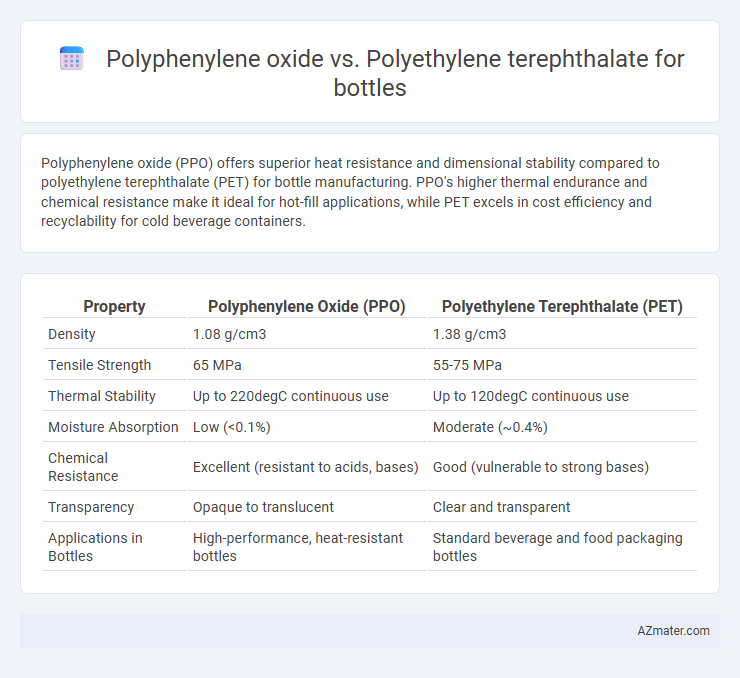Polyphenylene oxide (PPO) offers superior heat resistance and dimensional stability compared to polyethylene terephthalate (PET) for bottle manufacturing. PPO's higher thermal endurance and chemical resistance make it ideal for hot-fill applications, while PET excels in cost efficiency and recyclability for cold beverage containers.
Table of Comparison
| Property | Polyphenylene Oxide (PPO) | Polyethylene Terephthalate (PET) |
|---|---|---|
| Density | 1.08 g/cm3 | 1.38 g/cm3 |
| Tensile Strength | 65 MPa | 55-75 MPa |
| Thermal Stability | Up to 220degC continuous use | Up to 120degC continuous use |
| Moisture Absorption | Low (<0.1%) | Moderate (~0.4%) |
| Chemical Resistance | Excellent (resistant to acids, bases) | Good (vulnerable to strong bases) |
| Transparency | Opaque to translucent | Clear and transparent |
| Applications in Bottles | High-performance, heat-resistant bottles | Standard beverage and food packaging bottles |
Introduction to Polyphenylene Oxide (PPO) and Polyethylene Terephthalate (PET)
Polyphenylene oxide (PPO) is a high-performance thermoplastic known for its excellent dimensional stability, chemical resistance, and thermal stability, making it suitable for durable and high-temperature bottle applications. Polyethylene terephthalate (PET) is a widely used polyester resin favored for its clarity, strength, and excellent barrier properties against moisture and gases, commonly utilized in beverage and food packaging bottles. The distinct molecular structures of PPO and PET result in different physical and chemical properties, influencing their selection based on performance requirements in bottle manufacturing.
Chemical Structure Comparison: PPO vs PET
Polyphenylene oxide (PPO) features a rigid aromatic backbone with oxygen atoms linking phenylene groups, providing high thermal stability and dimensional integrity. Polyethylene terephthalate (PET) consists of repeating ester linkages between terephthalic acid and ethylene glycol units, offering excellent chemical resistance and mechanical strength. PPO's ether groups contribute to enhanced oxidative stability, whereas PET's ester bonds influence its hydrolytic degradation and recyclability in bottle applications.
Mechanical Properties: Strength and Durability
Polyphenylene oxide (PPO) exhibits superior tensile strength and impact resistance compared to Polyethylene terephthalate (PET), making it highly durable under mechanical stress. PPO's high heat deflection temperature enhances its dimensional stability in hot-fill bottle applications, whereas PET offers good strength but lower thermal resistance. The inherent rigidity and resistance to environmental stress cracking in PPO result in longer-lasting, more robust bottles ideal for demanding conditions.
Thermal Stability and Temperature Resistance
Polyphenylene oxide (PPO) exhibits superior thermal stability compared to polyethylene terephthalate (PET), maintaining structural integrity at temperatures up to 260degC, whereas PET typically begins to deform around 230degC. PPO's high glass transition temperature (Tg) of approximately 210degC allows bottles to resist thermal deformation in hot-fill applications, while PET's Tg near 75degC limits its use in such conditions. The enhanced temperature resistance of PPO makes it ideal for bottles requiring high thermal endurance, though PET remains favored for cost-effectiveness and clarity in moderate temperature uses.
Barrier Properties: Gas and Moisture Permeability
Polyphenylene oxide (PPO) exhibits superior gas barrier properties compared to polyethylene terephthalate (PET), with lower oxygen and carbon dioxide permeability rates, making it ideal for packaging applications requiring extended shelf life. PPO also demonstrates enhanced moisture resistance due to its low water vapor transmission rate, reducing the risk of product degradation from humidity. PET offers moderate barrier performance but is more cost-effective and widely used, while PPO's superior barrier capabilities come with higher material costs.
Processing and Manufacturing Techniques
Polyphenylene oxide (PPO) offers superior thermal stability and dimensional consistency during processing compared to polyethylene terephthalate (PET), allowing for higher-temperature molding and improved mold flow in bottle manufacturing. PET benefits from well-established injection molding and blow extrusion techniques, enabling efficient, high-speed production with excellent clarity and barrier properties. Manufacturing with PPO often requires specialized equipment to handle its higher melt temperature, while PET's extensive processing knowledge and recyclability make it the industry standard for lightweight, durable bottles.
Food Safety and Regulatory Compliance
Polyphenylene oxide (PPO) offers superior thermal stability and excellent chemical resistance, making it suitable for food contact applications requiring high temperature durability. Polyethylene terephthalate (PET) is widely approved by regulatory agencies such as the FDA and EFSA for food and beverage containers due to its proven inertness and strong barrier properties against moisture and oxygen. Both materials meet stringent food safety standards, but PET's extensive regulatory recognition and recyclability make it a preferred choice for mass-produced bottles.
Environmental Impact and Recyclability
Polyphenylene oxide (PPO) offers superior thermal stability and chemical resistance compared to polyethylene terephthalate (PET), but PET is more widely recycled due to its established recycling infrastructure and higher global recovery rates. PET bottles benefit from a well-developed circular economy, allowing efficient transformation into new packaging, textiles, and other products, reducing landfill waste and carbon footprint. The environmental impact of PPO is less documented, with limited recycling options and potential challenges in biodegradability, making PET the more sustainable choice for bottle manufacturing from an eco-conscious perspective.
Cost Efficiency and Market Availability
Polyphenylene oxide (PPO) offers higher cost efficiency in bottle manufacturing due to its excellent thermal stability and chemical resistance, reducing production defects and material waste. Polyethylene terephthalate (PET) dominates market availability with widespread use and established recycling infrastructure, making it more accessible and economical for large-scale bottling operations. The choice between PPO and PET depends on balancing PPO's superior performance characteristics against PET's volume-driven cost benefits and supply chain maturity.
Conclusion: Choosing the Right Material for Bottles
Polyphenylene oxide (PPO) offers excellent thermal stability, chemical resistance, and dimensional stability, making it suitable for bottles requiring durability and high-temperature applications. Polyethylene terephthalate (PET) provides superior clarity, lightweight properties, and cost-effectiveness, ideal for mass-produced beverage containers with high transparency needs. Selecting the right material depends on balancing factors such as mechanical performance, chemical resistance, visual appeal, and manufacturing cost requirements specific to the bottle's intended use.

Infographic: Polyphenylene oxide vs Polyethylene terephthalate for Bottle
 azmater.com
azmater.com